
Bread is found all around the world in many different shapes and, sizes, and flavours. Bread is often, consumed with family and friends bringing different people from different regions together.
Italy is no exception, producing hundreds of different kinds of bread throughout its history from every region. Bread has helped bring flavours and traditions from one side of the country to another, helping create some of the best- and well-known foods worldwide.
Humans have been baking bread for thousands of years and like many other things the Romans helped improve and take bread to the next level, even creating a baking school in the 1st century AD.
Every region within Italy has its own version of every kind of bread, due to available ingredients, variants in the cooking process, and cultural customs., however, in the end no matter how different they might seem, they are all Italian breads and helped make Italy’s the countries culinary prowess what it is today.
Despite how simple of a dish bread may seem, within Italy it is highly regarded and often served as its own course. It is never served with a carb-based dish as it is seen as too heavy. and Italian food is often served as many light courses in succession.
Actually bread It is often eaten in between larger dishes on its own with olive oil or another light sauce or with a soup, stew, or other lighter dish such as fish, and used to soak up the sauce.
If you are looking for some amazing fresh Italian bread and do not have the time to make it yourself, head over to Vincenzo’s either online or in-person and pick yourself up some delicious bread and pairings to go with it. Perhaps even check out our sandwiches which are ready for anyone on the go every day and made with our amazing selection of bread.

The history of bread is very long and very complicated as the true origins of bread are still speculated over to this day. However, we do for a fact know that bread was present in ancient Rome and bakers were considered important members of society as ritual loafs were often baked and offered during festivals to the Gods. This was so common that there were even a few churches with ovens built into them.
Romans were also the ones that discovered how to make the type of flour used within “white bread” as we know it today, while they were attempting to improve the milling process of wheat. In around 100 BC it is believed there were over 200 commercial shops that sold and baked bread in Rome. Around 200 years later in 100 AD the first baking school was established in Rome.
Despite common misconceptions all Italian bread is not the same as there are many different kinds varying by region and time period. As history progressed more and more bread types were popping up within Italy, as different regions gained access to different ingredients, leavening agents, and cooking methods.
As traveled methods improved these different recipes were spread all across the country and different variants were created born from such as each region put their own spin on each recipe. , and even different families would have varying recipes, in the same town, for the same type of bread.
There are a large variety of Some breads created throughout history Italy including Focaccia, Ciabatta, Brioche Tuppo, Pocaccia Barese, Pane Casareccio, and Ciambella, and many others. Some of these are more modern creations, such as Ciabatta which was only created in 1982.
Others, like Focaccia are older such as Focaccia, which can be traced as far back as the 2nd century BC where the Phoenicians, Carthaginians, Greeks, and tribes from Levant baked it using grains like millet, barely, and rye.
All are however, still considered staple Italian breads which can be found in one form or another all across the country.
The same breads from different regions of Italy can vary widely from one region to another. and yet at the same time can simply be a different variation of the same bread. Trying to narrow down which region a specific bread originated from will depend on how unique the bread is to the region,. for example, different variations of Focaccia can be found all across Italy and it is believed to have originated from Genova but no one really knows for sure where it first came from.it still cannot be proven for sure. The amazing thing about this regional diversity is that However, each region has its own specialties and puts their own twist on the flavor and texture of the bread. No matter what the differences are, they and all produce some of the best bread in the world., There isn’t one single region no one region being solely responsible for the advent of Italian bread.
Tuscany is located within central Italy and is known for its beautiful landscapes, history, art, and influence on culture. Simplicity is important within food in Tuscany which is why many legumes, breads, cheeses, vegetables, mushrooms, and fresh fruits are used in its cuisine. It is no surprise than that Tuscany is the birth place of many favourite Italian breads including, but not limited to, Cecina and Pane Altopascio.
Cecina is a Tuscan chickpea flour flatbread made up of only a few ingredients. Cecina comes from the Italian word Ceci meaning chickpea, hence the name for the chickpea flatbread. It is crispy on the outside with a soft inside. It is a relatively simple bread to make consisting of only five ingredients, chickpea flour, e.v.o oil, water, salt, and pepper with the optional addition of rosemary. Because it is such a simple recipe it is important that you use the best ingredients you are able to get ahold of to give it the best taste possible.
Liguria is located in the north-western region of Italy, containing both the Alps and the Apennines Mountain range. It is bordered by France, Piedmont, Emilia-Romagna, and Tuscany and rests along the Ligurian sea. Ligurian cooking consists mainly of seafood, vegetables, and beans, and they are the birth place of pesto, one of Italy’s most popular sauces known world-wide. Liguria is also the best-known region for Focaccia, one of the oldest and well-known Italian breads.
Focaccia is a flatbread similar to which is very similar to cooked pizza dough in both texture and appearance. Focaccia It can be made either sweet or savory depending on the ingredients and toppings you add on top of it. It is often and is mainly served very simply with typically only olive oil.
Focaccia is known as a great Italian street food, best served fresh and either plain, brushed with olive oil, or stuffed with vegetables, sausage, or cheese. Focaccia is either served at midday with a light lunch or as a snack throughout any time of the day with olive oil or balsamic vinegar.
Milan itself is not a technically a region within Italy, however, it is one of the largest cities in the country. Milan and sits within the region of Lombardy in the North of Italy. It is considered one of the fashion capitals of the world alongside Paris, France, London England, and New York. City USA, because of this it Milan is a high tourist area within Italy and provides visitors the ability to experience a lot of Italy’s rich culture in one place. Milan has a rich a unique history of its own, within Italy being one of the political capitals of the country, and is the wealthiest city in Italy.
Like most cities in Northern Italy, Milan also uses more rice than pasta, more butter than vegetable oil, and their cuisine features almost no tomatoes or fish. They are however, known for their seasonal dishes such as Colomba for Easter, Tortelli for Carnival, and Panettone for Christmas.
Panettone is a type of sweet bread originating in Milan, it is typically served during Christmas and New Year’s. It is enjoyed in Western, Southern, and Southeastern Europe as well as South America, Eritrea, the United States and Canada. It is shaped like a cake and traditionally contains raisins, candied orange, citron, and lemon zest which are added in dry rather than soaked, other variations can be found such as plain or chocolate. It is served in wedge shaped slices alongside a sweet hot beverage or a sweet wine. It can also be served with crema al mascarpone, a cream made from eggs, mascarpone, and sweet liqueur.

We hope you have enjoyed learning more about Italian breads and would love for you to come by the store and try on of these delicious Italian loafs. Or even better, check out our fresh, made-to-order sandwiches are a great lunch or dinner idea for the busy person on the go. You can custom choose your ingredients and pick one of our amazing breads to put it on.
